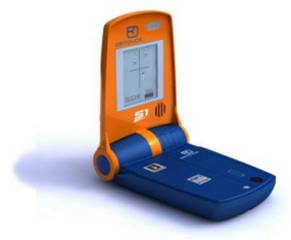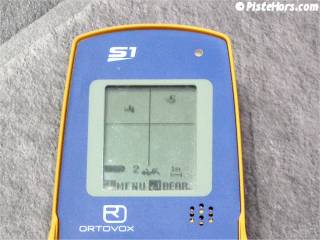
Gear > Avalanche Gear > Avalanche Transceivers > Digital Beacons > Ortovox S1

The Ortovox S1, announced last year in a blaze of publicity could be the beacon to stop the award winning Mammut Pulse. However there have been delays which have lead some to question whether the S1 was a marketing stunt or simply too ambitious. Talking to us in February 2006 Franz Kröll, part of Ortovoxs Communications team, didnt deny that they had had problems with the S1. Originally they wanted to use a single antenna design but he admitted this was slightly too ambitious given the information they wanted to display. Instead they have opted for a three antenna design similar to Mammut and Pieps and taken an extra year of development to get things right. Franzs says the third antenna is used for pinpointing and in fact two antennas give all the basic data needed to the processor.

Display showing two victims and their distance
The S1 is certainly the most futuristic of designs, resembling a Star-Trek communicator and its operation continues this theme, avalanche victims at 20 meters north-west and closing Capn. The clam-shell design may raise some eyebrows from mobile phone users regarding reliability but the case and display felt well built and solid. A dot-matrix style display is used but when the S1 boots up, instead of displaying the direction to each victim within range, their geographic location is shown with the position of the searcher indicated by a cross hair. The searcher simply has to move over the search site until the cross-hair is above the beacon symbol. When the searcher gets within 3 meters of the victim the third antenna comes into play to help with pinpointing and the display shows circles around the beacon the diameter of which gives an indication of distance. Once the victim has been confirmed the next beacon can be located. The beacon reverts to transmit mode if activity stops as would be the case with a secondary avalanche and will switch to analogue only if it runs short of power, not as useful but a failsafe to conserve the remaining battery and yet still offer some functionality.
The beacon is still in pre-production, the version we used on the stand worked fine for a two beacon search, but we were promised that first samples will hit the shops late in November 2006.
We recently spoke to Ortovox's French representative about the S1. No firm news yet on when the S1 will be ready. Winter 2006 is still being talked about. There are a couple of updates of note.
The display has been altered to only show beacons in front of the searcher rather than having a cross hair over the center of the search zone as shown in our picture from the 2006 ISPO. It was felt that the 360 degree view was confusing and not necessary as a searcher would be entering the search site with the device switched on so would already have covered the ground behind him. This has the advantage of focussing the S1 antenna on the area in front of the searcher and we guess it probably gives greater range, at least on the display.
The device will only display four beacons within the search zone. It was felt that 5+ beacon searches are extremely rare and this lets the software concentrate on typical rescue scenarios. With this change we can see that the Ortovox S1 is firmly aimed at the recreational skier who does not do much beacon practise rather than the pro-user or piste patroller.
The S1 is finally reaching the shops priced at a street price of around 400euros/$500.
<< Ortovox X1 | Digital Beacons | Ortovox d3 >>